This month we have a question about brake fluid from Ed Hilbert.
Hello David,
I am redoing all of my Mercedes brake components except for the steel brake lines which appear to be in good shape. What are the different types of brake fluid and when to use each type? Would I do well to change over to the newer silicone brake fluid or stick with the standard DOT type 3?
What are the advantages of the silicone over DOT 3 – perhaps silicone won’t absorb moisture and thus lessens the chance of rust? If I do change over, must I completely flush out the old fluid and if so with what – alcohol? How incompatible are the two types of brake fluid?
What is brake fluid made of? Why is it used instead of standard motor oil?
Can it be used as a paint stripper? If so, how would one clean it off the surface so paint would stick again?
Anything else we should know about brake fluid?
Thanks for your expertise!
Ed
Dear Ed,
The types of brake fluid are DOT 3, DOT 4, DOT 5 and DOT 5.1. DOT 5.1, like DOT 3 and DOT 4, is a polyethylene glycol-based fluid (contrasted with DOT 5 which is silicone-based). Polyethylene glycol fluids are hygroscopic and will absorb water from the atmosphere, necessitating a flush/replace every couple of years. Polyethylene glycol fluid WILL absorb moisture. Failure to replace contaminated brake fluid will lower the boiling point of the brake fluid, and the moisture will cause rust and corrosion of the brake system. Silicone, DOT 5 fluid will absorb just a minuscule amount of water.
Brake fluid is classified by its boiling point. The “dry” boiling point is with no moisture in the fluid. The “wet” boiling point is brake fluid with moisture in it. “Wet” brake fluid is defined as having 3.7% water by volume.
Dry boiling point Wet boiling point
- DOT 3 205 °C (401 °F) 140 °C (284 °F)
- DOT 4 230 °C (446 °F) 155 °C (311 °F)
- DOT 5 260 °C (500 °F) 180 °C (356 °F)
- DOT 5.1 260 °C (500 °F) 180 °C (356 °F)
I would highly recommend changing over to the DOT 5 Silicone fluid. Cars that I switched over to Silicone in the early 1980s have no issues, and the fluid continues to function well.
DOT 4 brake fluid has a higher boiling point than DOT 3, and is specified by many manufacturers for better braking performance.DOT 3, 4 and 5.1 brake fluid will remove paint, but there are much better paint removers. DOT 5 fluid, Silicone, will not harm paint. If it is accidentally spilled on the paintwork, it will not damage the paint, and can easily be wiped off.
I would imagine surfaces contaminated with brake fluid could be cleaned up successfully before painting.
DOT 5 Silicone brake fluid does have some drawbacks. It is very expensive, much more expensive than DOT 3 and 4. DOT 5 fluid can absorb air bubbles, and these air bubbles take some time to settle out. It can be difficult to bleed the air out when bleeding the brakes. Silicone fluid can not be used on vehicles with anti lock brakes.
I have been wrenching for years, and I have fixed countless cars with damage caused by moisture in contaminated brake fluid. I have had to free frozen pistons, and replace wheel cylinders, calipers and master cylinders due to rust and corrosion. I have also had my brakes fail due to the boiling point of the brake fluid being so low, that the fluid boiled resulting in the total failure of the brake system. Old brake fluid is extremely dangerous, as it can and will cause the brakes to fail without warning.
The ideal time to switch to Silicone fluid is when the rubber parts are all being replaced. Blow the metal lines out with compressed air, assemble the brake system and then flush with Silicone fluid until clean fluid comes out of the bleeder screws.
While somewhat expensive up front, if your car is a long term investment Silicone brake fluid will pay for itself many times over, saving you the cost of perpetual fluid replacement, the cost of repairs due to corrosion of brake components, and the cost of paint repair due to spilled brake fluid.
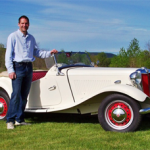 Please email all inquiries to: Dave
Please email all inquiries to: Dave
or snail mail
32 Turkey Hill Road
Richmond VT 05477










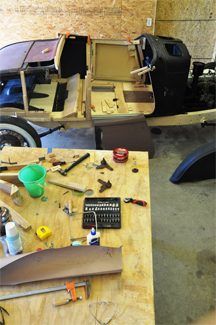 Ken Squier’s Plymouth came to him in parts and had spent many years in the garage of former owner Stewart Raydell of Williamstown, VT. Ken is very fast to say that he has had very little to do with working on the project. His step son-in-law, Sandy Thompson, has taken on all the wood related work between his obligations at his business building staircases and handrails at his company in Stowe. Most of the wood is ash and it appears Sandy has done a better job than the 1932 factory workers. The mechanical work is being done by Gary Scott of East Barre.
Ken Squier’s Plymouth came to him in parts and had spent many years in the garage of former owner Stewart Raydell of Williamstown, VT. Ken is very fast to say that he has had very little to do with working on the project. His step son-in-law, Sandy Thompson, has taken on all the wood related work between his obligations at his business building staircases and handrails at his company in Stowe. Most of the wood is ash and it appears Sandy has done a better job than the 1932 factory workers. The mechanical work is being done by Gary Scott of East Barre. 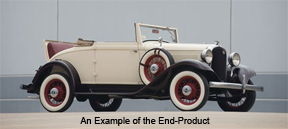 Gary has his own garage business and has a long history of working on Ken’s projects. Mr. Raydell’s neighbor, Steve Stephenson, remembers the car and told Wheel Tracks that he was the person who rebuilt the engine some 15 years age. At one time not too long ago there was a plan to have the car completed for the 2014 Stowe Car Meet this August but they all agree it might now be the 2015 meet instead. They have a ways to go yet.
Gary has his own garage business and has a long history of working on Ken’s projects. Mr. Raydell’s neighbor, Steve Stephenson, remembers the car and told Wheel Tracks that he was the person who rebuilt the engine some 15 years age. At one time not too long ago there was a plan to have the car completed for the 2014 Stowe Car Meet this August but they all agree it might now be the 2015 meet instead. They have a ways to go yet.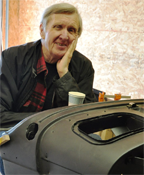 Ken Squier has a ‘bit’ of a history of being around cars and got started when he was 12 announcing sport events on his dad’s Waterbury radio station, WDEV. He was well known for his skill announcing live play-by-play dirt track races in Vermont during his younger years. His early Vermont announcing booth was an old logging truck. In fact he became so involved that he was able to convince NASCAR and CBS to get together and then basically created an announcing job for himself with CBS for many years.
Ken Squier has a ‘bit’ of a history of being around cars and got started when he was 12 announcing sport events on his dad’s Waterbury radio station, WDEV. He was well known for his skill announcing live play-by-play dirt track races in Vermont during his younger years. His early Vermont announcing booth was an old logging truck. In fact he became so involved that he was able to convince NASCAR and CBS to get together and then basically created an announcing job for himself with CBS for many years.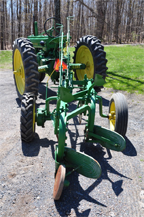 The family farm where I grew up in Milton had two tractors, a 1942 John Deere B and a 1929 Farmall F20. The F20 had steel wheels but was later converted to rubber tires making for a smoother ride and easier for the town road crews. I couldn’t wait to drive these tractors and finally when I was nine my dad agreed to show me how. That led to many hours of plowing, harrowing, planting, haying, sugaring, manure spreading, etc. Later, in 1959 Dad purchased a JD 435D, John Deere’s first venture into a small diesel tractor. This tractor had an engine built by General Motors, was made for only two years and is very collectible. That year, 1959, was the year I graduated from high school and left the farm eventually forming my own construction company where I still work.
The family farm where I grew up in Milton had two tractors, a 1942 John Deere B and a 1929 Farmall F20. The F20 had steel wheels but was later converted to rubber tires making for a smoother ride and easier for the town road crews. I couldn’t wait to drive these tractors and finally when I was nine my dad agreed to show me how. That led to many hours of plowing, harrowing, planting, haying, sugaring, manure spreading, etc. Later, in 1959 Dad purchased a JD 435D, John Deere’s first venture into a small diesel tractor. This tractor had an engine built by General Motors, was made for only two years and is very collectible. That year, 1959, was the year I graduated from high school and left the farm eventually forming my own construction company where I still work. Karmann Ghia is 60 years old…..When Wheel Tracks learned that 2013 was the Volkswagen Karmann Ghia’s 60th anniversary we thought it was a good idea to feature the car for our May issue. We asked club members for input and maybe even some stories about their Karmann Ghia’s they presently own or have owned in the past. The results was a surprise. There are only two listed in our VAE Roster and that appears to be it. WT has heard of a number of VW Beetle stories but we assume no other members own or have owned a Karmann Ghia. Our front page Ghia is owned by Ken Taplin of Blue Hill, Maine. The second Ghia, pictured to the right, is owned by your editor in Enosburg, Vermont, a 1968 Coupe.
Karmann Ghia is 60 years old…..When Wheel Tracks learned that 2013 was the Volkswagen Karmann Ghia’s 60th anniversary we thought it was a good idea to feature the car for our May issue. We asked club members for input and maybe even some stories about their Karmann Ghia’s they presently own or have owned in the past. The results was a surprise. There are only two listed in our VAE Roster and that appears to be it. WT has heard of a number of VW Beetle stories but we assume no other members own or have owned a Karmann Ghia. Our front page Ghia is owned by Ken Taplin of Blue Hill, Maine. The second Ghia, pictured to the right, is owned by your editor in Enosburg, Vermont, a 1968 Coupe.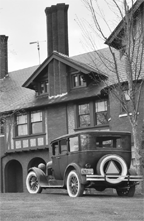 A comment on a VAE tour… “I could hear you and your ‘clutch’ behind me”
A comment on a VAE tour… “I could hear you and your ‘clutch’ behind me”